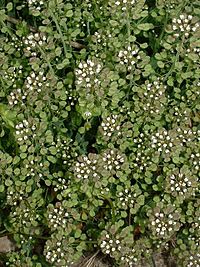Barton Bushes facts for kids
| Site of Special Scientific Interest | |

Cotswold Pennycress (Thlaspi perfoliatum)
|
|
| Area of Search | Gloucestershire |
|---|---|
| Coordinates | 51°55′55″N 1°50′27″W / 51.931954°N 1.840696°W |
| Interest | Biological |
| Area | 5.7 hectare |
| Notification | 1996 |
Barton Bushes is a special natural area in Gloucestershire, England. It covers about 5.7 hectares, which is roughly the size of five football fields! This site was officially recognized in 1996 as a Site of Special Scientific Interest (SSSI) because of its important plants and animals.
People in the local area sometimes call this place Barton Larches or Meadows Larches. It's located within the beautiful Cotswolds Hills, which is a protected area known for its stunning landscapes. Being part of the Cotswolds Hills Environmentally Sensitive Area (ESA) and the Cotswolds Area of Outstanding Natural Beauty means it's a very important place for nature and scenery.
Contents
What Makes Barton Bushes Special?
Barton Bushes is super important for several reasons. It's home to some very rare and special living things that need protection.
Rare Plants: The Cotswold Pennycress
One of the most exciting finds at Barton Bushes is a plant called the Cotswold Pennycress (its scientific name is Thlaspi perfoliatum). This small plant is nationally rare, meaning it's not found in many other places across the country. It loves to grow in the special type of soil found here, which is called unimproved limestone grassland. This kind of grassland hasn't been changed much by farming, so it's very natural and perfect for unique plants.
Special Butterflies: The Duke of Burgundy
Barton Bushes is also a great place for butterflies! It has a healthy population of the Duke of Burgundy fritillary butterfly. This butterfly is considered nationally scarce, which means it's not very common. These beautiful butterflies need specific plants to lay their eggs on and for their caterpillars to eat, and Barton Bushes provides just what they need to survive and thrive.
Important Habitats: Grassland and Scrub
Besides the rare plants and butterflies, the site itself is important. The mix of unimproved limestone grassland and scrub (areas with small trees and bushes) creates a perfect home for many different species. These habitats provide food, shelter, and breeding grounds for a variety of wildlife, making Barton Bushes a truly special place for nature.

